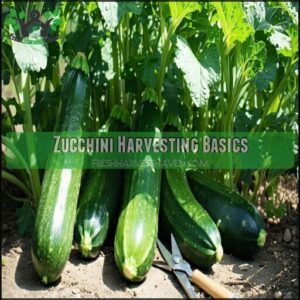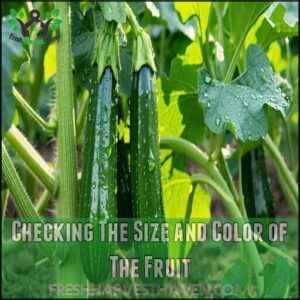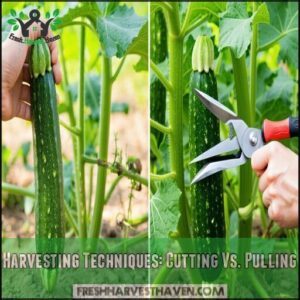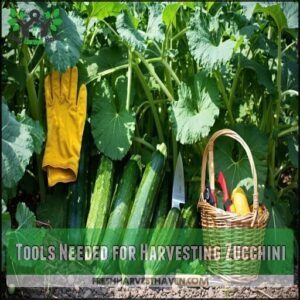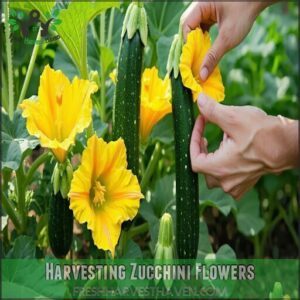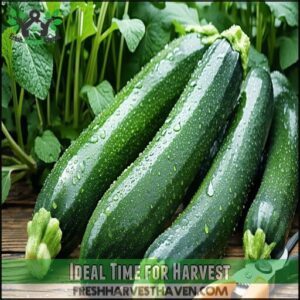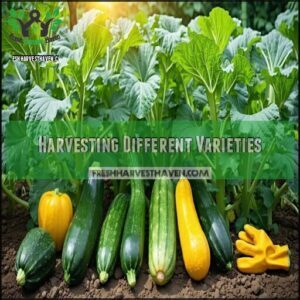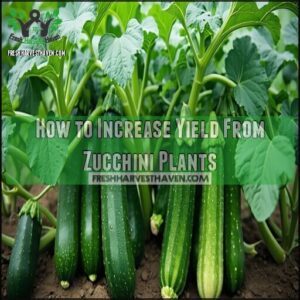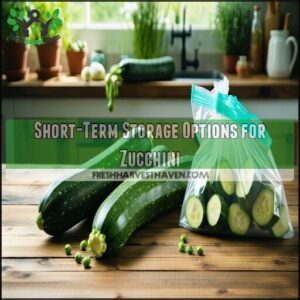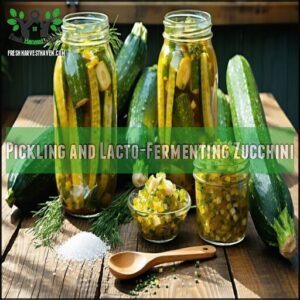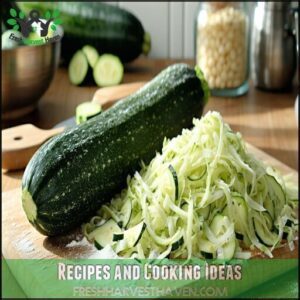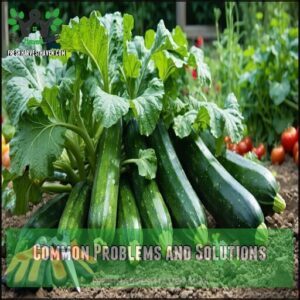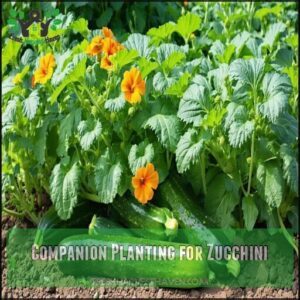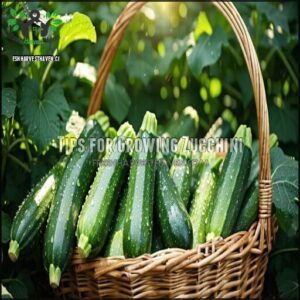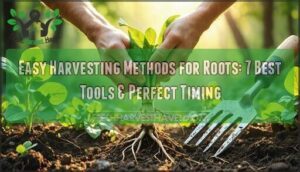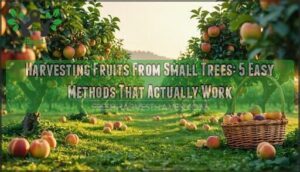This site is supported by our readers. We may earn a commission, at no cost to you, if you purchase through links.
 You’ll know it’s time to harvest zucchini when they reach 6-8 inches long – about the size of a flashlight.
You’ll know it’s time to harvest zucchini when they reach 6-8 inches long – about the size of a flashlight.
Don’t wait too long; those innocent-looking squash can balloon to baseball bat proportions overnight.
The perfect zucchini feels firm but not rock-hard, with glossy, rich-colored skin that gives slightly when pressed.
For the sweetest flavor, harvest in the morning when the sugar content is highest.
Simply cut the stem with sharp shears rather than pulling, leaving about an inch attached.
Regular harvesting actually encourages your plants to produce more – nature’s way of saying "the more you take, the more I’ll make".
Table Of Contents
- Zucchini Harvesting Basics
- How to Harvest Zucchini
- Ideal Time for Harvest
- Harvesting Different Varieties
- How to Increase Yield From Zucchini Plants
- Storing and Preserving After Picking
- Recipes and Cooking Ideas
- Common Problems and Solutions
- Companion Planting for Zucchini
- Tips for Growing Zucchini
- Frequently Asked Questions (FAQs)
- How long should a zucchini be before harvesting?
- When is the best time to pick zucchini?
- When to harvest zucchini squash?
- Does harvest time affect the taste of zucchini?
- How often should you pick zucchini?
- Can you grow zucchini if summer is short?
- What happens if you leave zucchini on the vine too long?
- Will zucchini plants keep producing?
- When should I Harvest zucchini?
- How often should a zucchini plant be harvested?
- Conclusion
Zucchini Harvesting Basics
You’ll know your zucchini is ready to pick when it reaches 6-8 inches long and has firm, glossy skin that yields slightly to gentle pressure.
Checking your plants daily during peak season will help you catch these summer squash at their prime flavor point, before they transform into those baseball bat-sized monsters hiding under the leaves, which is a key moment to catch them.
Types of Zucchini and Their Harvesting Periods
Your garden’s zucchini harvest timing varies dramatically by variety, with each type offering its own "sweet spot" for picking.
Understanding these differences helps you catch every squash at peak flavor and texture.
Here are 5 common zucchini varieties and their ideal harvest windows:
- Classic oblong zucchini – Pick at 6-8 inches long when skin is glossy and firm (typically 45-55 days after planting)
- Round varieties (like ‘Eight Ball’ and ‘One Ball’) – Harvest at baseball size, about 2-3 inches in diameter
- Bush-habit zucchini – Ready earlier than vining types, often producing fruit by day 50
- Striped varieties (like ‘Cocozelle’) – Best at 6-8 inches when distinctive stripe patterns are vivid
- Crookneck types – Perfect when neck is still flexible and fruit measures 4-6 inches
I’ve found that checking plants daily during peak season keeps you from missing that ideal harvest window—they grow faster than you’d think!
Factors Affecting Zucchini Harvest Time
In the journey from seed to harvest, your zucchini follows a timeline influenced by several key factors.
Understanding these variables helps you predict when those green gems will be ready for picking.
- Weather Impact: Warm, sunny days accelerate growth while cool spells can add weeks to maturity
- Soil Quality: Nutrient-rich, well-draining soil produces earlier, more abundant harvests
- Variety Selection: Different types mature at varying rates (35-75 days from sowing)
- Growing Conditions: Plants experiencing stress from pests or disease develop more slowly
- Watering Consistency: Regular moisture keeps production on schedule
Most varieties reach peak ripeness around 50 days after germination, but your specific harvest timing depends on this combination of factors.
Check your seed packet for the most accurate maturity timeline for your chosen variety.
Importance of Harvesting Zucchini at The Right Time
Beyond just picking veggies, timing your zucchini harvest directly impacts both flavor and your garden’s productivity.
Perfectly timed zucchini harvests mean tender, flavorful squash and an endless supply for fresh, delicious summer dishes.
While various factors influence growth rates, your harvest timing makes all the difference:
Nearly stops producing.
When you leave oversized fruits on the vine, you’re basically telling your plant "mission accomplished".
Watch for ripeness indicators like firm, glossy skin and that perfect banana-sized length. I’ve discovered firsthand—checking plants every 2-3 days during harvest season dramatically increases yield while guaranteeing the sweetest, most tender zucchini possible. Harvesting in the morning guarantees peak flavor potential.
How to Harvest Zucchini
You’ll need to know exactly how to harvest your zucchini properly to keep your plants producing all season long.
Once you’ve identified those perfectly-sized squash, grab your garden shears and cut about an inch above the fruit rather than tugging, which can damage those surprisingly delicate plants.
You should harvest in a way that supports the health of your plants, and this method will help ensure they remain productive.
Checking The Size and Color of The Fruit
Now that you understand the basics, let’s focus on what your zucchini should look like when it’s ready for picking.
Identifying the perfect zucchini harvest time comes down to recognizing the right visual cues. Most standard varieties reach their ideal size at 6-8 inches long—roughly the length of a dollar bill—with a diameter of about 2 inches.
When checking if your summer squash is ready:
- Look for skin glossiness that practically gleams in the sunlight
- Confirm a vibrant color (deep green for traditional types, bright yellow for golden varieties)
- Feel for firm flesh that gives slightly when pressed
- Check that seeds inside remain small and tender
- Consider variety differences (round zucchini should be baseball-sized)
Don’t wait until they’re gigantic—those monster zucchinis might make neighborhood jokes, but smaller fruits deliver superior flavor and texture. You’ll want to check your plants every 1-2 days during peak season since they grow surprisingly fast!
Harvesting Techniques: Cutting Vs. Pulling
You’ve spotted the perfect zucchini – now let’s get it off the plant without causing harm! The age-old debate of cutting vs. pulling has a clear winner in the context of zucchini harvesting.
Always choose cutting over pulling. Pulling can tear stems, stress plants, and reduce your overall yield. A clean cut, however, maintains stem attachment and promotes continuous production.
Here’s your perfect zucchini harvest technique:
- Support the fruit with one hand while making your cut
- Use sharp pruning shears or a knife to slice 1-2 inches above the zucchini
- Make a clean, angled cut to prevent moisture collection and disease
My neighbor learned this lesson the hard way – she yanked her first harvest and watched her plant struggle all season. Meanwhile, my carefully-cut plants produced zucchini for weeks longer!
The right harvesting tools and technique comparison prove that a little precision goes a long way in preventing plant damage and maintaining zucchini freshness.
Tools Needed for Harvesting Zucchini
After learning that cutting beats pulling for zucchini harvest, it’s time to gear up with the right tools for the job!
Every successful zucchini gardener needs sharp garden pruners or a quality garden knife like a hori hori for clean cuts.
Keep pruning shears well-maintained for smooth harvesting. Consider buying specialized cutting tools for superior results.
Don’t forget sturdy gloves to protect your hands from those prickly stems and leaves!
When cutting, aim to leave about 1 inch of stem length attached to your squash.
A small basket will keep your harvest organized while you work through the patch. Your hands (and plants) will thank you!
Harvesting Zucchini Flowers
Once you’ve gathered your zucchini fruits, don’t overlook those edible blooms adorning your plants! With the same garden shears, you can harvest zucchini flowers for culinary adventures.
To collect these delicate treasures:
- Identify flower types – male flowers have thin stems and prominent stamens, while females have tiny zucchini bulges at their base
- Harvest in early morning when flowers are fully open but before they wilt in afternoon heat
- Snip male flowers just below the bloom, leaving a few on each plant for pollination
- Collect female flowers sparingly, as they’ll become your future zucchini crop
Store harvested flowers in the refrigerator between damp paper towels for up to two days. They’re perfect for stuffing with cheese, battering and frying, or adding colorful accents to summer salads, making them a great addition to your summer salads with their colorful accents.
Ideal Time for Harvest
You’ll know it’s time to grab your garden shears when your zucchini reaches 6-8 inches long with a firm, glossy skin that yields slightly to gentle pressure.
Morning harvests give you the juiciest, most flavorful squash when they’re full of moisture but haven’t yet baked in the midday sun, which is a key factor for the best flavorful results.
Harvesting Zucchini in The Morning
Dew-kissed and plump, zucchini harvested in the morning delivers peak flavor and ideal firmness that afternoon picking simply can’t match.
| Morning Harvest Benefit | Why It Matters |
|---|---|
| Maximum Hydration | Crispier texture, longer shelf life |
| Reduced Pest Activity | Fewer insects to dodge while picking |
| Cooler Temperatures | More comfortable harvesting experience |
| Flower Impact | Male flowers remain open for pollination |
Grab your pruners before 9am when your squash contains the most moisture. You’ll notice they’re heavier and more vibrant than those picked midday. This early routine yields better-tasting zucchini and also encourages continuous production throughout the season.
Harvesting Zucchini at The Right Stage of Maturity
The golden moment for harvesting zucchini arrives at specific maturity stages that guarantee perfect flavor and texture in your summer squash.
Timing is everything!
Your zucchini has reached harvest-ready maturity when it shows these key indicators:
- Standard varieties measure 6-8 inches long (baseball-sized for round types)
- Skin feels firm yet yields slightly to fingernail pressure
- Color appears deep, uniform, and vibrant across the entire fruit
- Surface has a glossy sheen without any hardening spots
Don’t wait too long! Zucchini can grow from tiny to massive overnight, and those smaller fruits actually offer superior taste.
Daily garden check-ups prevent you from ending up with tough, seedy monsters. Remember, frequent harvesting actually stimulates your plants to produce more, keeping your kitchen stocked with tender, delicious zucchini all season long.
How to Check for Readiness
Now that you understand when to harvest, you’ll need to know exactly how to check if your zucchini is ready for picking.
Look for these clear indicators:
- Size Matters: Perfect zucchini typically measures 6-8 inches long and 1.5-2 inches in diameter—any larger and you risk tough skin and bitter flavor.
- Skin Texture: Ready-to-harvest zucchini has glossy, firm skin that yields slightly to gentle pressure without feeling hard or rubbery.
- Color Indicators: Look for vibrant, consistent coloring without yellowing patches (unless it’s a yellow variety!).
Trust these signs—I’ve seen garden-ready zucchini double overnight when ignored!
Harvesting Different Varieties
You’ll need different timing cues for specialty zucchinis like pattypans, rounds, and crooknecks, since each has its own ideal harvest size.
Just like you wouldn’t wear one-size-fits-all gardening gloves, you shouldn’t use the same harvesting rules for every summer squash variety.
When to Harvest Pattypan Zucchini
When should you harvest those quirky pattypan squash in your garden? These UFO-shaped summer squash are ready to pick when they reach 2-4 inches in diameter, typically 45-70 days after planting.
| Pattypan Size | Color Indicators | Skin Texture | Best Uses |
|---|---|---|---|
| 2 inches | Bright white/yellow | Tender, thin | Quick stir-fries |
| 3 inches | Fully colored | Firm, yielding | Stuffing, grilling |
| 4 inches | Deep color | Slightly firm | Roasting whole |
| Over 4 inches | Dull appearance | Tough, hard | Seeds may be developed |
Harvest twice weekly for continuous production – they grow surprisingly fast! It is essential to pick them at the right time to ensure optimal flavor and texture.
When to Harvest Round Zucchini
Watching your round zucchini varieties reach their perfect harvest moment is like witnessing small green planets coming into orbit.
Unlike their elongated cousins, rounded types like ‘Eight Ball’ and ‘Piccolo’ follow different sizing rules.
Your round zucchini is ready when:
- It reaches softball sizing (or baseball size for the sweetest flavor)
- The skin glossiness appears uniform with a vibrant sheen
- Gentle pressure meets slight resistance but not hardness
- The stem and flower attachment still look fresh
Most round varieties peak at 2-3 inches in diameter for tender eating, though some can grow to 6 inches while maintaining quality.
Check plants daily as they grow surprisingly fast!
Variety differences matter—lighter colored types may need different visual cues than dark green ones.
For maximum flavor, harvest in early morning when fruits are most hydrated.
When to Pick Crookneck Zucchini
The curved elegance of crookneck zucchini demands timely harvesting for peak flavor and texture.
The characteristics of ready to harvest and too mature crookneck zucchini can be summarized as follows:
You’ll want to check your summer squash daily, as crooknecks can double in size overnight! Harvest when they’re bright yellow with tender skin texture and before seed maturity makes them bitter.
For best color and flavor, pick in the morning using sharp scissors, leaving a 1-inch stem. Remember: frequent harvest visits encourage more production.
How to Increase Yield From Zucchini Plants
You can turn your modest zucchini patch into a summer-long squash factory with just a few simple tweaks to your gardening routine.
Frequent harvesting, proper nutrition, and a little help with pollination will keep your plants producing like they’re trying to win a vegetable contest, utilizing simple tweaks to achieve this goal.
Frequent Harvesting and Its Benefits
Your zucchini’s success hinges on frequent harvesting—it’s the gardener’s golden rule.
The secret to zucchini abundance is simple: harvest often and your plants will respond with even more fruit.
Regular picking triggers continuous production while preventing those baseball bat-sized surprises hiding under leaves.
Here’s why consistent harvesting matters:
- Stimulating Growth – Each harvest signals the plant to produce more flowers
- Preventing Overgrowth – Small squash (6-8 inches) taste better than giant ones
- Maintaining Health – Reduces plant stress and disease risk
- Encouraging Flowers – Daily checks guarantee timely harvest timing
Providing Adequate Nutrients and Water
To boost your zucchini yield, focus on nutrient management from the ground up.
Keep soil pH between 6.0-7.0 for ideal nutrient absorption. Apply balanced fertilizer (10-10-10) every 3-4 weeks during growing season. You can find fertilizer products online.
Water deeply 1-2 inches weekly—more during heatwaves, less during rainy periods.
Mulch with 2-3 inches of straw or compost to retain moisture and suppress weeds.
Watch for yellowing leaves (nitrogen deficiency) or purple tints (phosphorus issues).
For soil health maintenance, add compost tea monthly to introduce beneficial microorganisms that enhance nutrient availability and root development.
Hand Pollination Techniques
Many gardeners face poor zucchini yields when pollinators are scarce. Hand pollination is your simple solution!
Here’s how to manually pollinate:
- Identify flowers: Look for male flowers (with thin stems and stamen) and female flowers (with tiny squash at base).
- Collect pollen: Use a small paintbrush to gather pollen from the male flower’s stamen during morning hours when pollen is most viable.
- Transfer carefully: Gently brush the collected pollen onto the stigma in the center of female flowers.
This bee-mimicking technique guarantees the best timing for fruit development and boosts your summer squash harvest substantially!
Storing and Preserving After Picking
You’ll need to properly store your freshly harvested zucchini to enjoy that garden-fresh taste beyond summer’s end.
From refrigerating for a week to freezing grated squash for winter bread-making, learning a few simple preservation techniques can save you from the classic gardener’s dilemma of having way too much zucchini all at once, which involves complete concepts like planning and proper storage.
Short-Term Storage Options for Zucchini
Freshly harvested zucchini deserves proper storage to maintain its garden-fresh quality.
After picking your summer squash, you have two main short-term options to keep it crisp and delicious.
- Countertop Storage: Perfect for zucchini you’ll use within 1-2 days. Simply place them in a cool spot away from direct sunlight. No need for bags—let them breathe!
- Fridge Storage: For longer freshness (up to a week), store unwashed zucchini in perforated plastic bags in your crisper drawer. Only wash right before cooking, as moisture accelerates spoilage.
Handle your harvest gently to prevent bruising, which shortens shelf life.
Remember: the ripeness impact is real—slightly immature zucchini actually stores better than fully mature ones!
Freezing and Dehydrating Zucchini
Now that you’ve stored your fresh zucchini, let’s preserve that summer bounty for winter enjoyment.
Blanching methods matter—submerge slices in boiling water for 3 minutes before cooling quickly. For freezing, spread shredded zucchini flat on trays before bagging to prevent clumping. Many resources discuss various blanching products for ideal results.
The dehydration time typically runs 8-12 hours at 135°F until pieces snap when bent. Storage containers should be airtight—vacuum-sealed bags or glass jars work best.
Frozen zucchini uses include soups and baking, while dehydrated zucchini recipes range from crunchy chips to powdered soup thickeners. You’ll thank yourself when garden-fresh flavors brighten winter meals!
Pickling and Lacto-Fermenting Zucchini
While freezing preserves your zucchini bounty, pickling and fermenting transform those garden gems into tangy, probiotic-rich treats that’ll wake up your taste buds.
You’ll need fresh, firm zucchini harvested at peak ripeness for the best lacto-fermentation results. The fermentation process uses natural lacto-bacteria to create zingy flavors while boosting nutritional benefits.
- Create a proper pickling brine with sea salt, filtered water, and seasonings like dill and garlic
- Keep zucchini below the brine line to prevent mold during fermentation
- "Burp" your jars daily to release carbon dioxide buildup
- Wait patiently as your zucchini kimchi or fermented relish develops complex flavors (typically 3-7 days)
This ancient food preservation method turns ordinary zucchini into extraordinary snacks!
Recipes and Cooking Ideas
You’ll transform those perfectly harvested 6-inch zucchinis into mouthwatering meals that even veggie-skeptics can’t resist.
From crispy grilled spears with a hint of lemon to hidden shreds in chocolate cake that’ll fool your kids, your summer squash harvest is about to become the star of your kitchen, with mouthwatering meals.
Grilled and Roasted Zucchini Recipes
Your perfectly harvested zucchini transforms into culinary magic when grilled or roasted! Those 6-8 inch squash you’ve diligently picked are ideal for these cooking methods.
Slice your zucchini into ¼-inch planks or rounds, brush with olive oil, and add seasonings—I’ve found that a simple mix of garlic powder and oregano works wonders. Grill for 3-4 minutes per side until those beautiful char marks appear.
For busy weeknights, try halved zucchini roasted at 400°F until caramelized and tender. For more inspiration, explore summer vegetable recipes that complement zucchini’s mild flavor. Trust me, it’s a game-changer!
| Preparation | Cooking Time | Flavor Pairings |
|---|---|---|
| Sliced rounds | 6-8 minutes | Lemon & herbs |
| Halved boats | 15-20 minutes | Parmesan & garlic |
| Kebabs | 8-10 minutes | Balsamic glaze |
| Ribbons | 4-5 minutes | Mint & feta |
These nutritional powerhouses shine with simple preparation, letting your summer harvest take center stage. Nothing beats the flavor of freshly grilled zucchini you’ve grown yourself!
Zucchini Noodle and Stir-Fry Recipes
Transform your just-harvested zucchini into delicious, quick meals that showcase its garden-fresh flavor.
- Classic Zoodle Preparation with a spiralizer creates perfect noodle alternatives in just minutes
- Asian Zucchini stir-fry with ginger, garlic and soy creates a savory weeknight wonder
- Protein Pairings like shrimp or tofu turn zucchini dishes into complete meals
- Vegetarian Options shine when zucchini meets mushrooms and bell peppers
- Stir-Fry Sauces from simple lemon-herb to spicy peanut elevate every bite
These summer recipes let you enjoy your harvest without heating up the kitchen.
Try tossing zoodles with pesto or adding diced zucchini to a five-spice stir-fry for dinner tonight!
Baked Goods and Desserts Using Zucchini
Turn your abundant zucchini harvest into five delicious baked treats your family will devour!
Classic zucchini bread and chocolate zucchini bread transform this summer squash into moist, sweet slices that’ll disappear before they cool.
For variety, try zucchini muffins packed with nuts or chocolate chips, or a decadent zucchini cake topped with cream cheese frosting.
Sweet variations like lemon-zucchini bars or zucchini brownies cleverly hide vegetables in dessert form.
The beauty of these recipes?
Shredded zucchini adds incredible moisture without any veggie taste.
When your garden’s overflowing, these baking projects are far more appealing than another stir-fry, and they offer a great way to use abundant zucchini harvest and enjoy delicious baked treats with moist, sweet slices.
Common Problems and Solutions
Even the most attentive gardeners run into zucchini troubles, from baseball-bat sized overlooked squash to plants that stubbornly refuse to produce.
You’ll find practical fixes for these common zucchini challenges, whether you’re dealing with pest problems, disease issues, or just wondering what on earth to do with that monster zucchini hiding under the leaves, which can be considered a common zucchini challenge.
What to Do With Overripe Zucchini
Don’t throw away those monster zucchinis that got away from you! When you stumble upon overripe, seed-filled squash with tough skin, you’ve got plenty of options:
- Scoop out seeds and stuff as savory zucchini boats
- Shred into quick breads and muffins for moist baking uses
- Process into animal feed for chickens or rabbits
- Create hearty soups after removing fibrous parts
- Add to compost for excellent garden nutrition
Overripe management just requires a little creativity! Consider crop rotation annually to help prevent future garden problems.
How to Handle Zucchini Pests and Diseases
While salvaging overripe zucchini has its merits, protecting your plants from pests and diseases requires vigilance.
Check plants daily, inspecting leaf undersides for squash bugs and cucumber beetles. If you notice wilting or yellowing leaves, act fast—these are early warning signs of common diseases.
For organic solutions, try neem oil sprays or soapy water to combat aphids. Prevention beats treatment: practice crop rotation, maintain proper spacing, and use disease-resistant varieties.
Remember, healthy zucchini plants naturally resist problems, so consistent watering and good airflow are your best allies in pest control. **Regular monitoring is essential to catching diseases early and saving your plants.
Dealing With Zucchini Plants That Are Not Producing
Many zucchini plants become stubborn non-producers, leaving gardeners scratching their heads.
If yours won’t deliver, check these common culprits:
- Pollination problems – Not enough bees visiting? Use a small paintbrush to transfer pollen from male flowers (with thin stems) to female flowers (with tiny zucchini bases).
- Soil deficiencies – Nutrient-starved plants need balanced fertilizer to jumpstart production.
- Watering issues – Too much or too little water stresses plants; aim for consistent moisture.
- Pest infestation – Squash bugs and vine borers can devastate production.
Remember, proper zucchini plant care requires understanding growth stages and ensuring good sunlight exposure—your plants will thank you with abundance!
Companion Planting for Zucchini
You’ll boost your zucchini harvest by strategically placing the right plant neighbors in your garden bed.
While you’re checking those squash for the perfect picking size, don’t forget that friendly companions like nasturtiums and marigolds can help keep pests away and improve your overall yield.
How to Plant and Care for Companion Plants
When you plant companions alongside your zucchini, you’ll create a thriving mini-ecosystem that benefits all plants involved.
Strategic placement of these helper plants makes all the difference in your zucchini’s health and productivity.
Here’s how to set up your companion planting strategy:
- Plant aromatic herbs like basil and mint 12-15 inches from zucchini to repel pests while attracting beneficial pollinators
- Add marigolds and nasturtiums around the perimeter for natural pest control and vibrant garden color
- Incorporate nitrogen-fixing beans or peas nearby to improve soil health without extra fertilizers
- Install trellises for climbing companions to optimize space while providing partial shade
- Leave 18-24 inches between plant groups to guarantee proper airflow and growth support
Remember to regularly weed around your companion plants and maintain consistent watering for both zucchini and their helpful neighbors to ensure a healthy garden ecosystem and promote proper airflow.
Benefits of Companion Planting for Zucchini
Boost your zucchini’s performance with strategic companion planting—it’s like giving your garden a secret weapon! Companion plants work alongside your zucchini to create a healthier, more productive growing environment.
Here are 3 game-changing benefits of companion planting:
- Pest Control – Marigolds and nasturtiums naturally repel squash bugs and cucumber beetles, while alyssum prevents aphid infestations without competing for space.
- Pollinator Attraction – Plants with yellow blossoms like nasturtiums attract bees and other beneficial insects that improve pollination, directly increasing your zucchini yield.
- Soil Health – Herbs like basil and oregano improve soil nutrients, while zucchini’s broad leaves act as living mulch, retaining moisture and suppressing weeds.
By implementing nitrogen-fixing legumes, you can also enrich the soil naturally.
By combining these companion planting strategies, you’ll create a mini ecosystem that naturally protects your zucchini while reducing your workload. It’s gardening smarter, not harder!
Tips for Growing Zucchini
You’ll get the best zucchini harvest when you match your variety to your climate and give these thirsty plants consistent water throughout the growing season.
While zucchini aren’t particularly fussy, they’ll reward your attention with armloads of squash that seem to appear overnight—sometimes leaving you wondering what to do with your twentieth zucchini of the week, which can be a bit of a challenge to manage, but the reward is well worth the effort.
Choosing The Right Variety for Your Climate
When selecting zucchini varieties, your local climate plays a vital role in determining success.
Check the seed packet for days to maturity to match your growing season length.
| Climate Type | Regional Favorites | Key Benefits |
|---|---|---|
| Cool/Short Season | ‘Black Beauty’, ‘Raven’ | Matures in 45-55 days |
| Hot/Humid | ‘Costata Romanesco’, ‘Cocozelle’ | Disease resistance, tolerates moisture |
| Dry/Arid | ‘Grey Zucchini’, ‘Yellow Crookneck’ | Drought tolerance |
| All-Purpose | ‘Ambassador’, ‘Dunja’ | Adaptable to various growing conditions |
| Container/Small Space | ‘Eight Ball’, ‘Patio Star’ | Compact growth habit |
Climate considerations matter—choose wisely! Local climate and growing season length are crucial for success, and selecting the right variety can provide disease resistance and drought tolerance.
Soil Preparation and Fertilization
How can you grow the juiciest zucchini? Start with stellar soil! Aim for a pH between 6.0-7.5 using a simple home testing kit. Your zucchini craves loose, fertile ground that drains well.
Mix 3 inches of nutrient-rich compost or well-rotted manure into the top 6 inches of native soil before planting. This organic matter buffet provides essential nutrients while improving soil texture.
When plants start flowering, apply a balanced 10-10-10 fertilizer to keep them fed. For container gardens, use lighter potting mix with ample drainage.
- Pro Tip: Create small hills or mounds for planting—this improves drainage and gives roots room to develop properly.
Providing Adequate Sunlight and Water
After preparing nutrient-rich soil, your zucchini’s thirst for sunshine and water needs attention.
Zucchini plants crave sunlight! Position them where they’ll bask in at least six sunlight hours daily—that’s their energy smoothie.
For watering frequency, follow this golden rule: deep, infrequent soakings beat daily sprinkles. Check soil moisture with the finger test—if it’s dry an inch down, it’s drinking time.
Good drainage solutions prevent root rot while maintaining consistent hydration.
Frequently Asked Questions (FAQs)
How long should a zucchini be before harvesting?
Think of zucchini as Goldilocks’ choice—harvest when it’s just right.
Aim for 6-8 inches long and firm with glossy skin.
Too big? It’s tough.
Too small? Flavor’s lacking.
Check daily; they grow fast!
When is the best time to pick zucchini?
The best time to pick zucchini is when they’re 6-8 inches long, with glossy, firm skin.
Harvest in the morning for peak hydration, and don’t wait too long—overgrown zucchinis lose flavor and tenderness quickly!
When to harvest zucchini squash?
Like finding the perfect avocado, harvest zucchini when it’s 6-8 inches long, firm, and shiny.
Check daily—they grow fast!
Morning is ideal for picking, keeping them tender and flavorful while encouraging more growth.
Does harvest time affect the taste of zucchini?
Yes, timing impacts zucchini’s taste.
Harvest too late, and it’s tough and bitter; too early, and it’s bland.
Aim for 6-8 inches long—perfectly tender, flavorful, and just right for your recipes!
How often should you pick zucchini?
You should pick zucchini every day or every other day during peak season.
These plants grow fast, and frequent harvesting keeps them tender, flavorful, and encourages more production.
Skip a day, and they’ll surprise you!
Can you grow zucchini if summer is short?
You can absolutely grow zucchini in a short summer.
Choose fast-maturing varieties, start seeds indoors, and use row covers for warmth.
Zucchini grows quickly, so you’ll still enjoy a harvest before cooler weather hits.
What happens if you leave zucchini on the vine too long?
Leaving zucchini on the vine too long is like letting a balloon overinflate—it gets tough, seedy, and loses flavor.
Overgrown zucchinis develop hard skin, bitter taste, and can stunt the plant’s future production.
Will zucchini plants keep producing?
If you harvest zucchini regularly, the plants will keep producing all season until frost.
Think of it like a "use it or lose it" situation—frequent picking encourages more flowers and fresh fruit.
When should I Harvest zucchini?
Think of zucchini like Goldilocks—harvest when it’s just right!
Aim for 6-8 inches long with glossy, firm skin.
Check daily; they grow fast! Picking often keeps plants productive and your meals delicious.
How often should a zucchini plant be harvested?
Check your zucchini plants daily or every other day, especially in warm weather.
These sneaky veggies grow fast, and frequent harvesting keeps them tender while encouraging the plant to produce more.
Don’t let them hide!
Conclusion
Timing is everything in the context of harvesting zucchini.
Waiting too long can turn tender squash into oversized, bland giants, while picking too early might sacrifice flavor.
Keep an eye on size, firmness, and color to verify your zucchini is at its peak.
Morning harvests offer the sweetest results, and regular picking encourages more growth.
By knowing the best time to harvest zucchini, you’ll enjoy a steady supply of fresh, delicious squash all season long. Happy gardening!
- https://foodal.com/recipes/pickles-and-fermentations/bread-butter-zucchini-pickles/
- https://www.gardeningknowhow.com/edible/vegetables/zucchini/zucchini-squash-diseases.htm
- https://www.homesandgardens.com/gardens/zucchini-diseases
- https://gardenplanner.almanac.com/pests/us-and-canada/plant-problems/zucchini-pests-identification/
- https://www.youtube.com/watch?v=TwSMLRxfhts&pp=ygUjI2NoaW5hZ3Jhc3NtYW5nb2J1cmZpYmFuYW5la2F0YXJpa2E%3D

